Alaska Fish & Wildlife News
May 2018
Bear Spray - From the Other Side
First aid and other tips
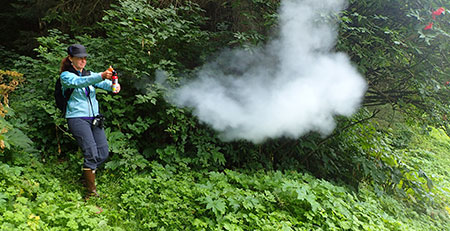
For many years I treated bear spray like a first-aid kit – it went in the pack on day hikes and camping trips and I never used it. Over time I learned to actually wear the can of spray so I could grab it quickly, and I practiced with inert spray to get a feel for using it. People who had sprayed bears assured me it works, but I also learned things that changed the way I thought about it.
Blowback is one aspect I never considered.
As a state wildlife biologist, Dave Battle has pepper-sprayed black bears dozens of times in hazing situations. A few years ago he found himself on the receiving end. Battle was called to deal with a problem bear, a young black bear, at a home in a wooded Anchorage neighborhood. It’s a situation he’s familiar with and he had a good idea how things would play out.
“I figured I’d spray it and it would run off into the woods,” he said. “It climbed up a tree, and it was just about three feet off the ground. The wind felt calm. I sprayed it and it got down and started to run off, and there must have been a light breeze because the spray came back on me. For about 20 seconds I felt like I couldn’t breathe, and I couldn't see. I couldn’t open my eyes at all. I knew it would pass, so I just sat down.”
He said it passed quickly and in a few minutes he could see again and breathe normally.
That’s a far cry from a direct hit. Jenny Twito, a nurse at Bartlett Regional Hospital in Juneau, said Emergency Department staff treat people who have gotten a face-full of pepper spray.
First Aid and Treatment
At Bartlett they keep milk and oil on hand. Emergency Department Director Kimberley McDowell wrote:
“We use cooking oil and milk for exterior surfaces, for eye exposures we irrigate with copious amounts of normal saline…The last exposure I took care of I used milk and it worked great, but again milk is not the course of treatment for eye exposure.”
The spray is oily, and cool water is not very effective in removing oil. Dish soap works, but at Bartlett they’ve found it helps to add oil first.
Nurse Jenny Twito said she applies vegetable oil or olive oil to the area to bind with the capsaicin oil in the spray, and then uses Dawn dish soap to wash it off. She uses milk to soothe the skin after washing. “For sensitive areas flushing with lukewarm clean water for 15-20 mins is the best practice,” she wrote.
Safeguard Self Defense in Rocklin, California, provides a wide range of pepper sprays, and the website for their online outlet, the Pepper Spray Store, offers detailed advice for first aid. Mike Davis granted permission to reprint sections.
The first rule is do not rub your face or eyes. “Resist this urge as much as possible…It won’t help, and … the instant you do this the burning sensation will increase ten-fold and it will spread.”
People react differently, and some respond better to treatment. Regardless, it’s going to burn for a while. If you are sprayed in the face and you wear contacts, take them out as soon as possible. Throw them away, they’re ruined.
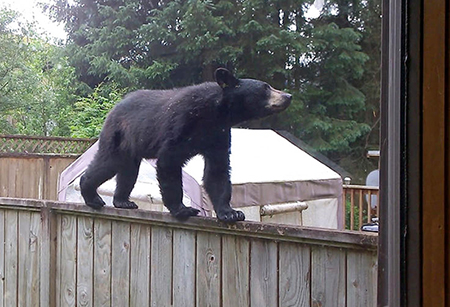
They recommend first applying whole milk to the affected area. It can be splashed on, a clean towel can be saturated with milk and laid over the affected area, or the affected area can be submerged in milk. It will help take away the burning sensation, but it will not remove the oils in the spray. That is step two.
They recommend a solution of 25 percent Dawn dishwashing soap and 75 percent water. “Use cold water and make up at least a gallon because you are going to have to wash the affected area at least seven or eight times. If your face is contaminated mix the detergent in a bowl that is deep enough to immerse your face in for 10 or 15 seconds at a time. Let the detergent start to do its job of breaking down the oils. “
Do not wipe, just let the cool, soapy water sit. After a few minutes a solution-saturated towel can be used to dab or gently wipe the skin, although it may burn. “This is normal so try to remain calm and patient. Decontaminating yourself from pepper spray can take as little as 15 minutes to as much as 45 minutes before symptoms subside. Recovery depends greatly on your skin type. Once you can readily touch your face without too much discomfort you can use a little more pressure to work the solution in. At this point rinse your face between the applications.”
Getting Sprayed
Chad Rice works for Fish and Game and oversees operations at the bear viewing area at Pack Creek. The U.S. Forest Service also shares management of the area. Rice received training in the use of bear spray as part of broader law enforcement training, and said he was in the last class where volunteers could opt to get sprayed as part of the training.
He wrote: “I have experienced a full dose. The reason was to show participants that if you remain calm and breathe you can still function so as not to be fully incapacitated. We don’t do this anymore. For me it made the prospect of experiencing blowback or residual spray less worrisome. After the class I knew that it would be uncomfortable but manageable.
… I learned to concentrate in breathing and force yourself to open your eyes. Do not rub your eyes as much as you will want to, it will only make it worse. As soon as practical flush your face and eyes with cold, fresh water. Do the same for clothes or other exposed skin as it is easy to re-expose yourself.”
Pete Schneider is a natural resource specialist with the U.S. Forest Service in Juneau. He trains Forest Service staff in the use of bear spray, and has also had first-hand experience with a face full of bear spray. While it was “horribly unpleasant,” it was a valuable experience, he said. It provided some insight into what could happen in a real self-defense situation.
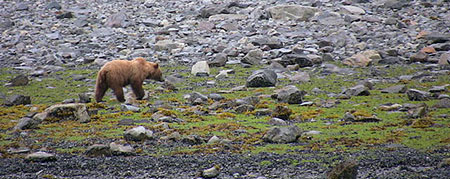
“If you need to use bear spray, there is a high chance you will get some on you,” he said. “The odds are good you will be affected directly or indirectly, and you may still need to function. In the best case scenario the bear runs away, but it might not – it could be really distracted by the spray, but it’s still there, and you might need to make an exit. And even if your eyes are barely working, your arms and legs will still work.”
In his experience, the most dramatic effect was on his breathing. He was gasping and felt like he was getting about 10 or 20 percent of a breath. “It was really hard work to breathe, just to take shallow breaths,” he said. “My throat closed up. My sinuses ran uncontrollably and I had to pretty much hold my eyes open to see. My skin felt like it was burning.”
He jumped in a cold shower, which helped, but he said he soon got an “ice cream headache” from the cold water. “I tried to get it a little less cold, closer to lukewarm and it was horrible. The warm water will open your pores and send you through the roof.”
He said that shampoo and bar soap weren’t really working, so he got out and grabbed liquid dish soap from the kitchen. It worked better, and he actually washed his eyes with it. The effects diminished over about two hours.
“Bears are way tougher than we can even imagine, but their sense of smell is so acute,” he said. “I think that’s why pepper spray has carved out a niche over the years as such an effective tool. You spray a bear and you have created a new number-one concern for the bear, it’s not you anymore.”
Most brands of bear spray note that they will spray continuously for seven or eight seconds, (some brands say about five seconds) but short blasts are recommended. The cloud appears to spray out 15 or 20 feet, but that cloud is still pretty potent even when it’s not visible. Schneider recommends a blast of two seconds or less, getting a cloud of spray between you and the bear. If you get the bear in the face, don’t keep spraying, just leave. You want to get away from the bear and the spray in the air. (Don’t run – walk away and keep an eye on the bear as you go).
He said during training, he’ll demonstrate with cans of expired spray. He’s careful about the wind direction and where students are located, but the spray can carry.
“It’ll carry over 100 yards,” he said. “Not the oil so much as the smell. I’ve sprayed it and 30 seconds later a little pocket will swirl around and you get the smell, which affects your breathing, like tear gas.”
The inert spray has a distinct, harmless odor. I’ve smelled the inert spray many times when I’ve practiced with it or demonstrated, and I realize that’s what he’s talking about. With real pepper spray, that smell would likely have me tearing up and gasping. Schneider said it’s unpleasant, but it passes quickly and it’s nothing compared to actually getting the spray on you. “I got a full-on shot in the face,” he said. “Most people won’t be hit like that, but with cross-contamination.”
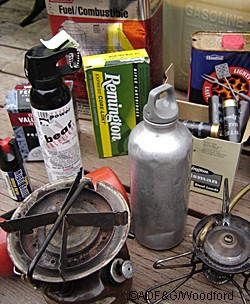
Terry Schwarz once sprayed a persistent black bear on his porch and got a surprise. He opened the door, reached out, and gave the bear a quick blast of spray. “I pulled my arm back in and when I shut the door, it created a draft that pulled some spray into the house. My wife immediately reacted, she was choking and threw up a little bit and her eyes were tearing. It didn’t affect me quite as much but it was bad. We just washed our faces with cold water and it passed in a few minutes.”
The bear was gone for good.
Flying with bear spray
Bear spray is not allowed on commercial flights. If you need bear spray, the TSA suggests you buy it at your destination and leave it behind when your trip is over. But what about that last leg – the flight out to the backcountry in a small plane?
You can take bear spray, but you must tell the carrier and the pilot must know. It requires special handling. Carl Ramseth is with Alaska Seaplanes, a Southeast Alaska regional service, which has planes on both floats and wheels. Bear spray is defined as a hazardous material, he said.
“You can fly with it, but it needs to be declared,” he said. “We ask passengers as they check in – people on scheduled flights as well as people going to remote locations. People don’t realize it could be a problem, so we always ask. There is paperwork filled out. We transport it in a sealed can, stored in a part of the aircraft that is not in the main cabin, so there is no risk of it going off in the cabin. Or it goes in the float compartment of a float plane.”
Some carriers use a length of heavy duty black PVC sewer pipe, four inches in diameter and threaded with caps at both ends. Several cans can be stacked and sealed in the tube for transport.
Carrying the spray
Jason Rupp is a bear viewing guide at Lake Clark. He has never sprayed a charging bear, but he has sprayed brown bears that have persistently and repeatedly investigated the camp.
“Sub-adults can get pretty rowdy,” he said, “and last year we had one that was getting worse and worse.”
The bear was about 30 feet away when he sprayed it, and he said it took about a second for the spray to reach the bear. “He snorted, and then it was like he had been kicked by a horse. He ran like a bat out of Hell, like he’d gotten an electric shock. I don’t think they understand what happened when they get sprayed.”
Dave Battle said he has never had a bear not run when sprayed. “They’ve always taken off,” he said. He added that as a state biologist, hazing a bear also involves dealing with whatever is attracting the bear, and that sometimes means a citation to a homeowner.
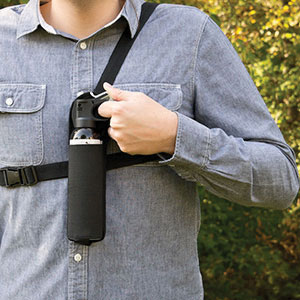
Battle and Rupp both emphasized the importance of wearing the can of spray on your person. Rupp prefers a holster attached with Velcro to the strap of his daypack, so it’s right on his chest. Chad Rice prefers a belt harness. He said he knows some people who clip the can to the outside of their pack, and he’s seen this lead to accidental discharge.
“I try to use that as reinforcement to carry it at their side,” Rice wrote. “..The other point I talk with them about is checking that the safety operates effectively and is attached to the can with a lanyard. If the safety is too loose the can should be retired to avoid accidental discharge. The lanyard is important so the safety is not lost if removed. We follow expiration dates strictly. If there isn’t an expiration (and some don’t have them) we generally retire after two field seasons. Oh, one more last tip, write the expiration date on the bottom of the can with a sharpie as the label will be unreadable in short order after getting wet and dirty. Any doubt, retire the can.”
Battle said he’s amazed at how many people he encounters on trails who are carrying bear spray in an inaccessible location. “I can’t tell you how many people I meet on the trail, and if we start talking, I ask them, ‘You carry bear spray?’ And they say, ‘Yeah, I've got it,’ and I say, ‘I can’t see it,’ and it’s buried down in their pack. I’ve given people holsters on the trail and put my spray in my pocket.”
Schneider said if you don’t carry your bear spray where you can get to it immediately, you might as well not bother bringing it. He carries his spray in a big cargo pocket in his pants.
“Every time people talk about a bear event, they say, ‘My God, it happened so fast.’ It always happens fast - if it didn’t happen fast, you probably wouldn’t be in the situation at all,” he said. “You’d have made a different decision and avoided the encounter.”
Battle said his brief exposure would not discourage him from using bear spray for self-defense.
“Don’t let fear of bear spray prevent you from using bear spray,” he said. “Better to get some spray than to get mauled by a bear.”
Riley Woodford is the editor of Alaska Fish and Wildlife News.
Complete first aid advice from the "Pepper Spray Store" site (scroll down).
What you should know about bear spray PDF
Subscribe to be notified about new issues
Receive a monthly notice about new issues and articles.
